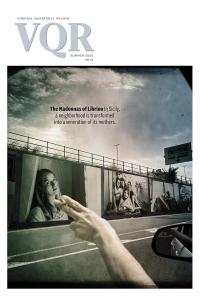
Mothers, Birds, Borders
This issue features the kind of striking, expansive photography that has come to define this magazine for the better part of two decades. Lynn Johnson’s portfolio of portraits revolves around a visionary art project that has turned a hardscrabble Sicilian neighborhood into a public veneration of the community’s mothers. Veteran reporter Bianca Stancanelli pens the introductory essay (translated by Antony Shugaar), through which readers will come to know the history of a fascinating, often-overlooked part of Southern Italy.
Meanwhile, Alessandro Cosmelli’s portraits and landscapes bring Marzio Mian’s in-depth reporting tour of the Russia–Estonia border—arguably among the most vulnerable borders in Europe’s face-off with Russia—to life. This story is part of a long-running collaboration between Mian and Cosmelli, who have spent the past year exploring East-West “collision points” in the context of Russia’s recent aggression. They deliver a sensory-loaded account of life along the Estonian border—with all its tension and even flashes of macabre humor—showing us exactly what it looks like when geopolitical stability begins to weaken.
Finally, Mandy Barker has constructed a layered photo essay with the hypnotic pull of a cabinet of curiosities. This time, however, the main subjects are Australia’s Flesh-footed Shearwaters, birds that mistakenly but habitually feed on the tiny plastic debris in the surrounding ocean waters. Barker’s visual autopsy, complemented by Saskia Beudel’s introduction, is both mesmerizing and chilling. Through an elegant cataloging of the Shearwaters’ plight, it does more than any white paper on the impact of marine pollution, archiving the ravages of plastic in the Earth’s waters.
This issue also includes Sofi Thanhauser’s essay on how the “war on cancer”—a campaign originating with the Nixon administration’s public-health platform—has been a boon for Big Pharma while providing cover for Congresses that have yet to address the environmental causes of this notorious disease.
In Donovan Hohn’s reported essay on 2024’s double emergence of cicada broods, an entomological inquiry becomes a meditation on the measures of time and the fluid relationship between humankind and its understanding of the fauna that surround it.
Posthumous poems from the great Nikki Giovanni lead our poetry in this issue, accompanied by a short cycle from Catherine Pond and work from Leslie Harrison, Erin L. McCoy, and Sacha Marvin.
In all three of the issue’s short stories—from Mimi Lok, Bill Cheng, and William Pei Shih—the protagonists’ understanding of themselves is shaped by the degree to which they know another. A mother’s emotional manipulation is laid bare at lunch; a dead blues legend coalesces but dissolves again as a scholar tries to pin him into place; the head of a music conservatory abuses his position by rejecting a submission from a student whose brilliance both astounds and threatens him.
The #VQRTrueStory columns see Louie Palu continue his behind-the-scaffolding look into the performances of politics on Capitol Hill and JDSH reinterpret the parameters and implications of the ubiquitous (and now fraught) visa photo. Illustrator Gambineri introduces a second installment to his comic series, CMYK. And Walton Muyumba continues his Deep Cuts column with a close reading of Meshell Ndegeocello’s musical translations.
